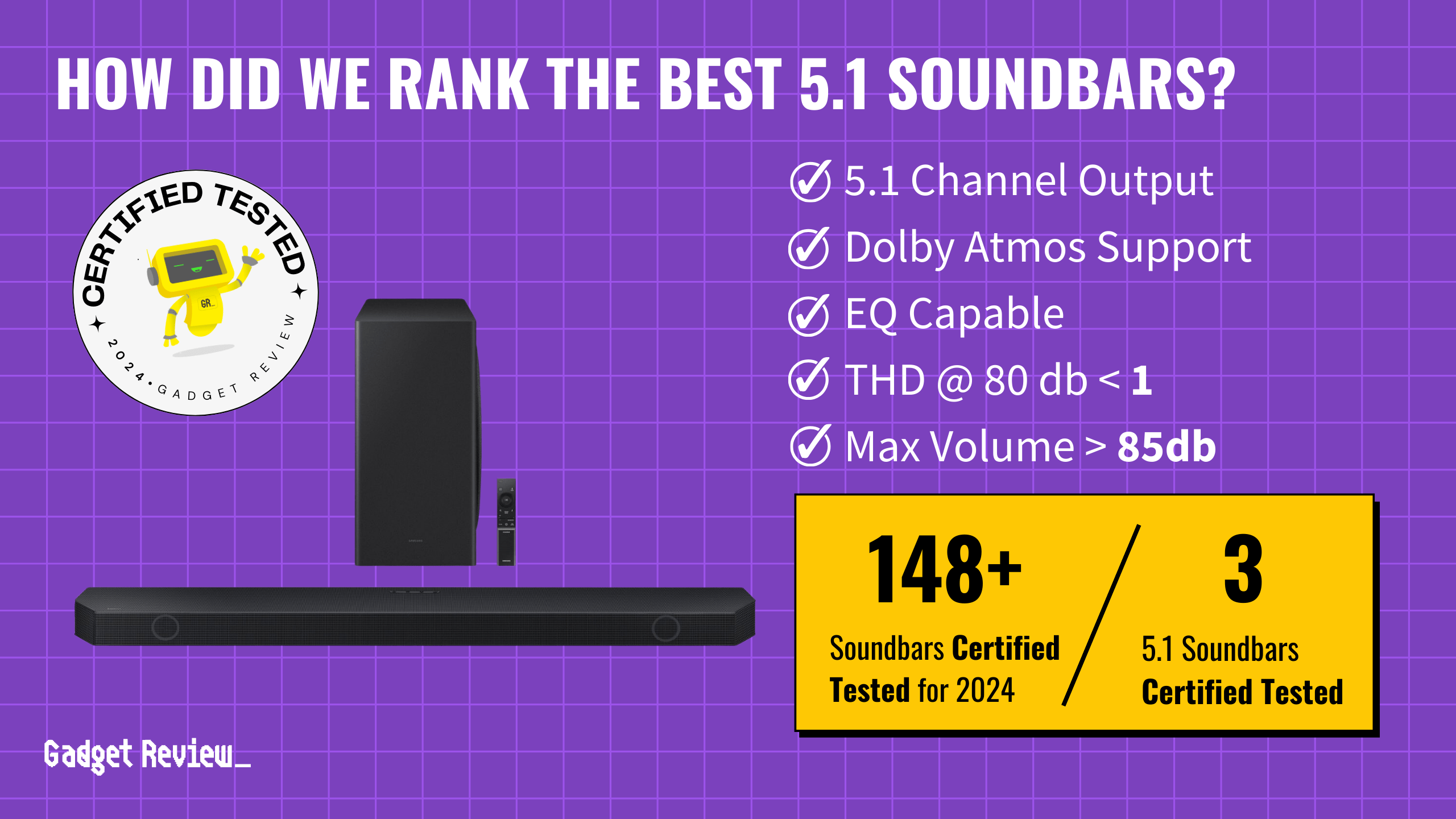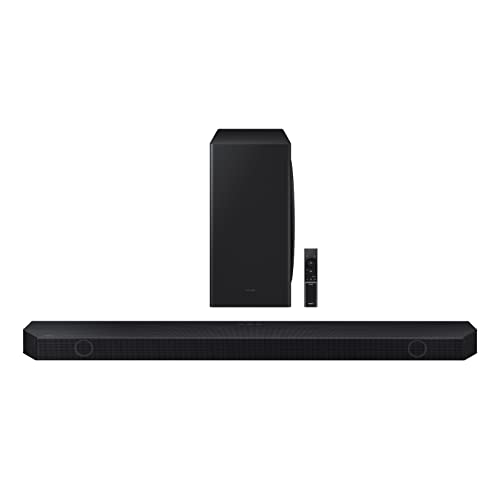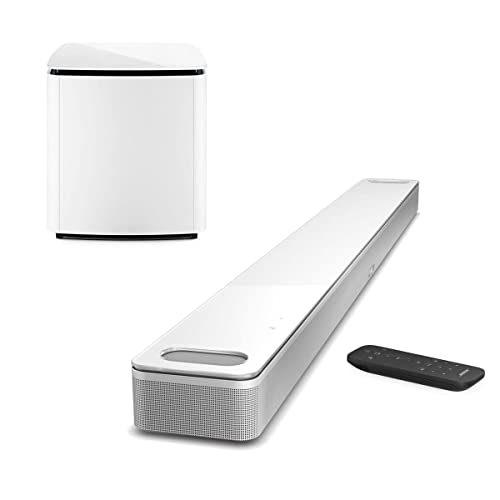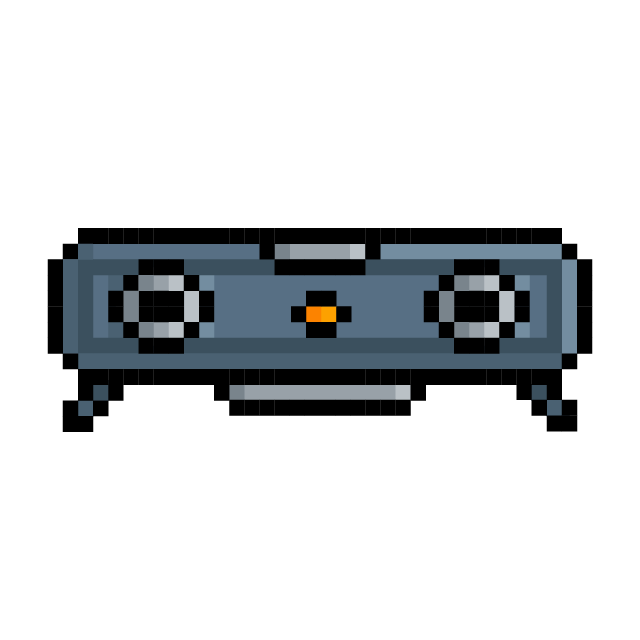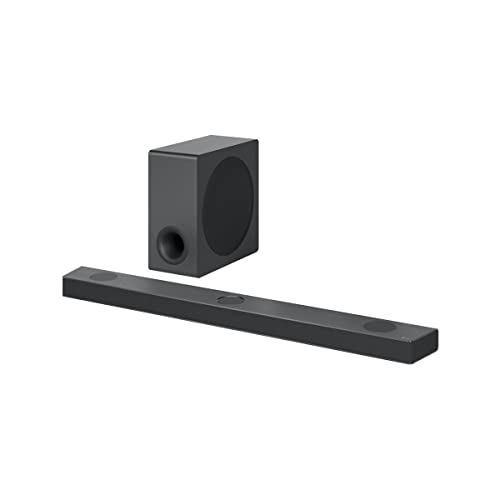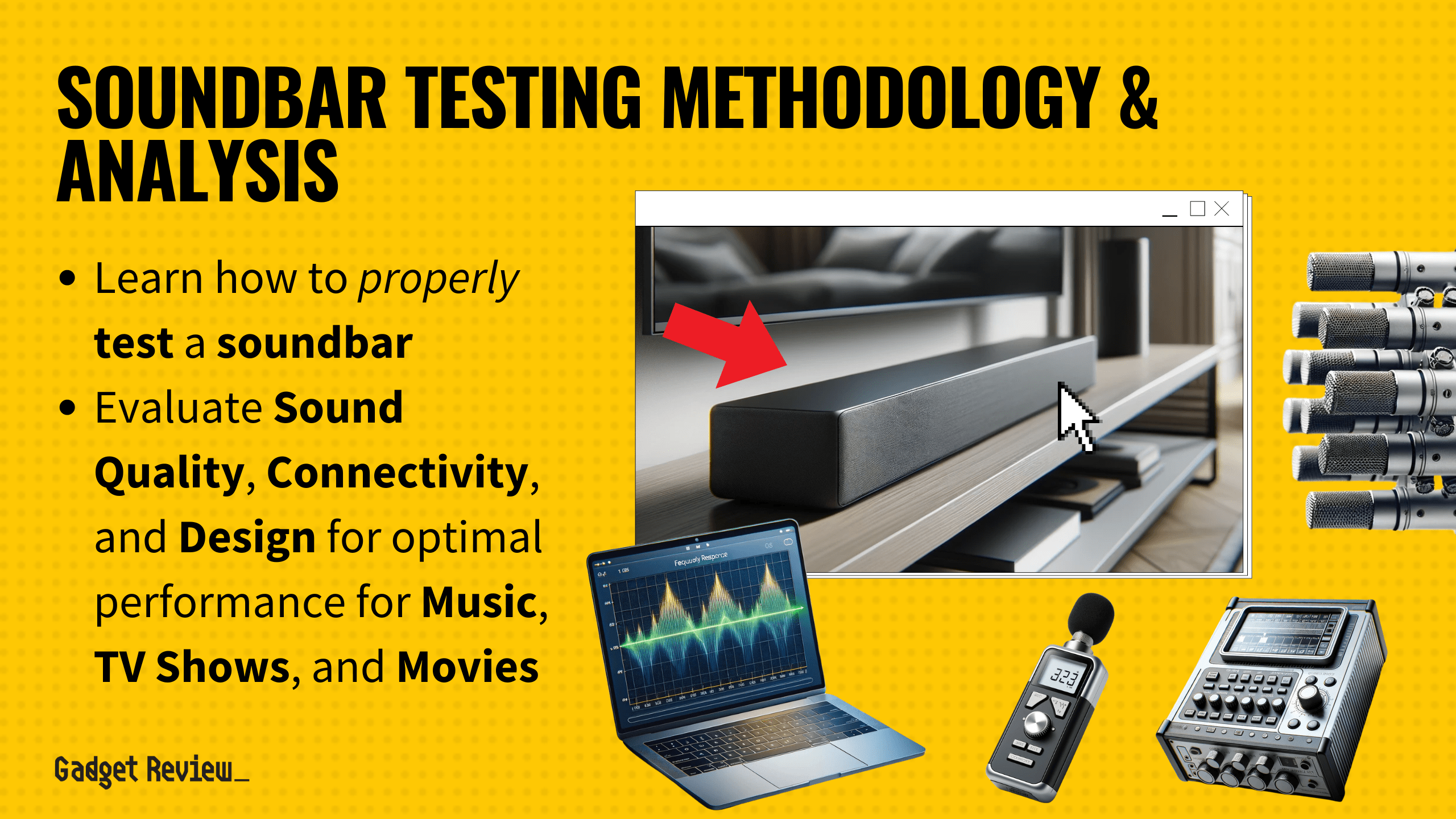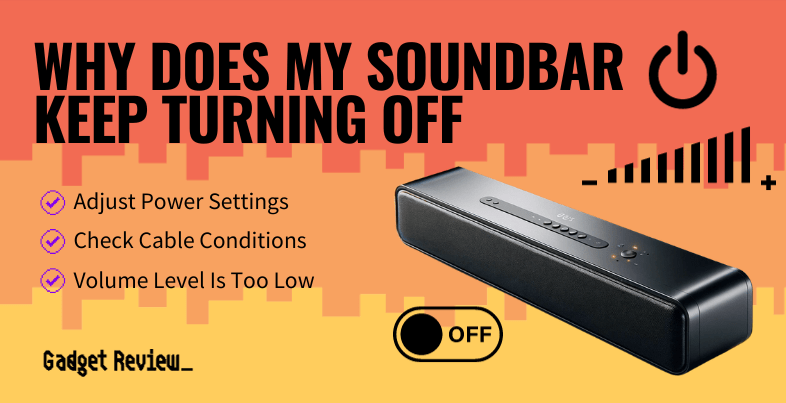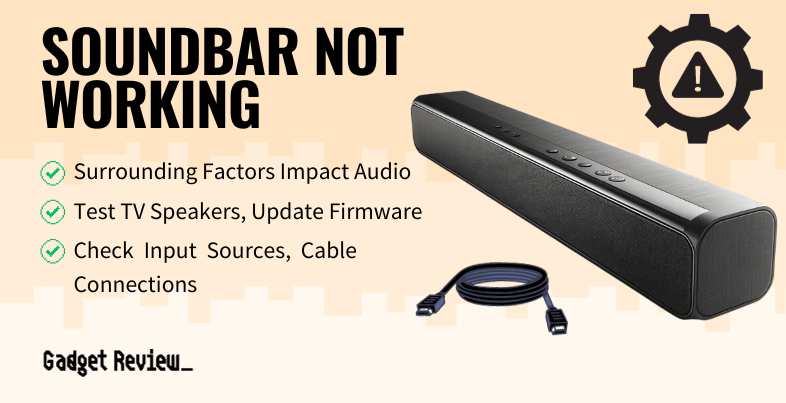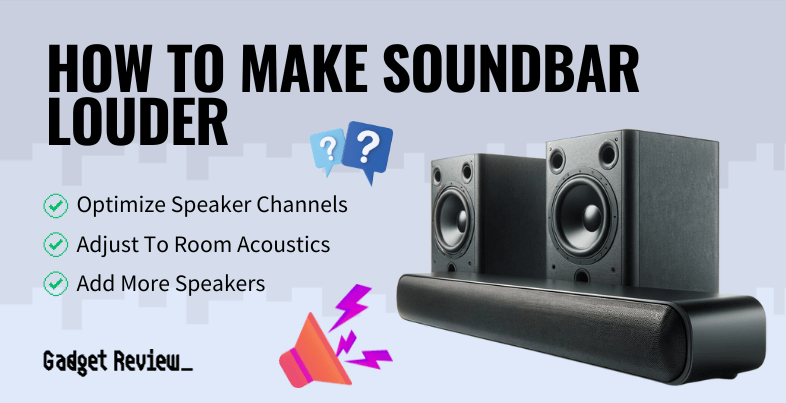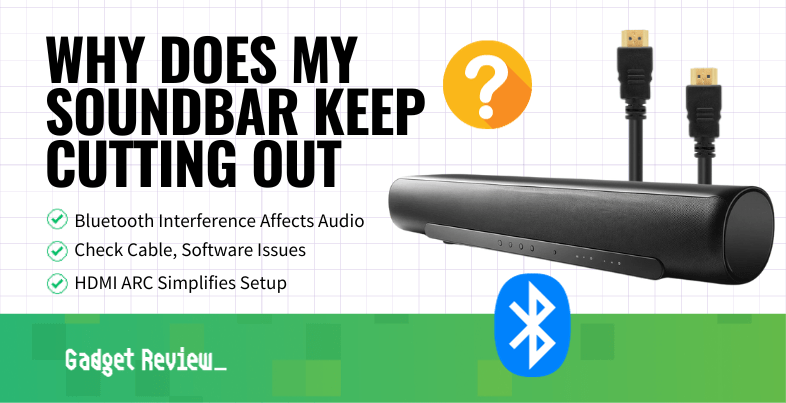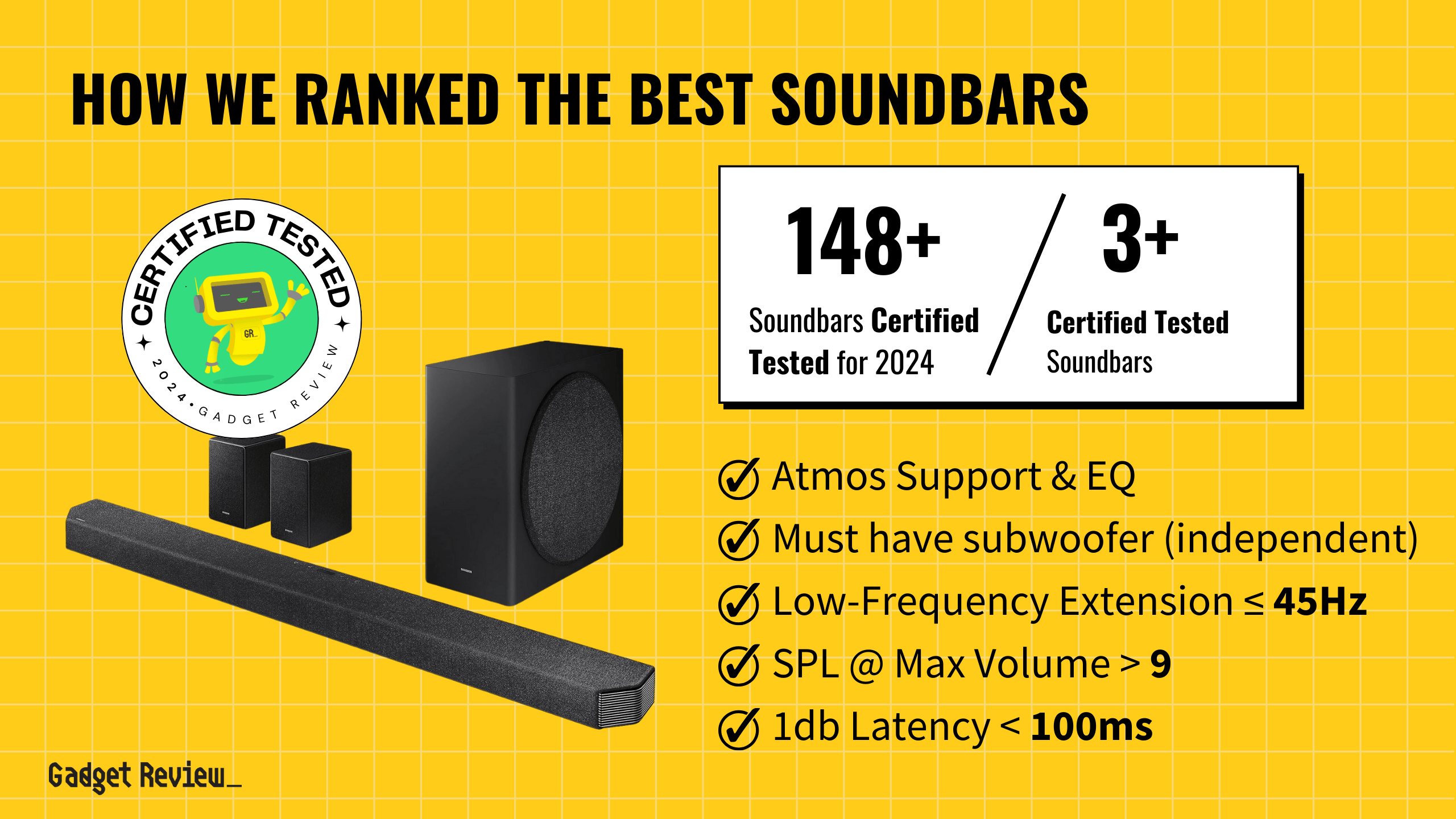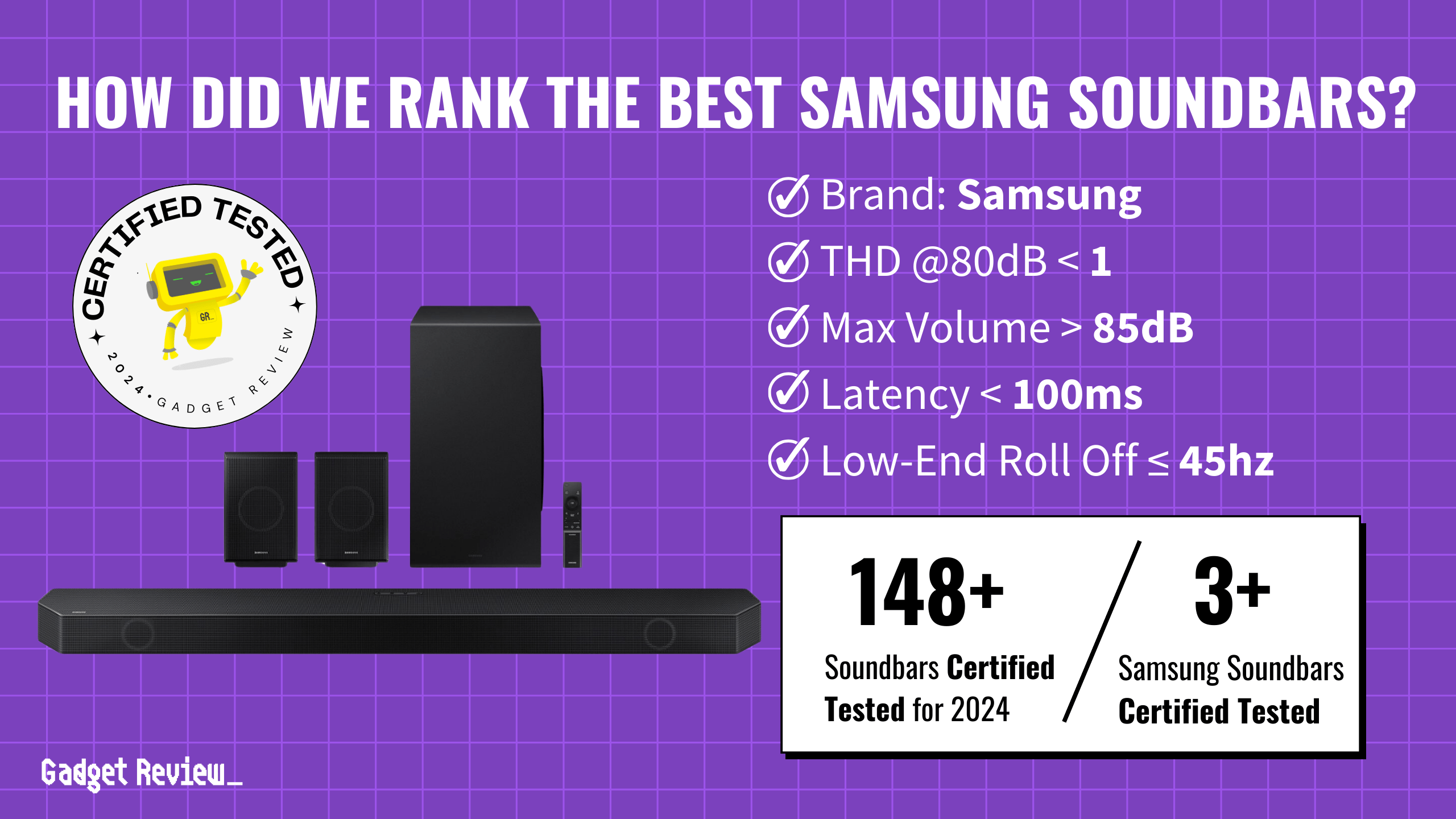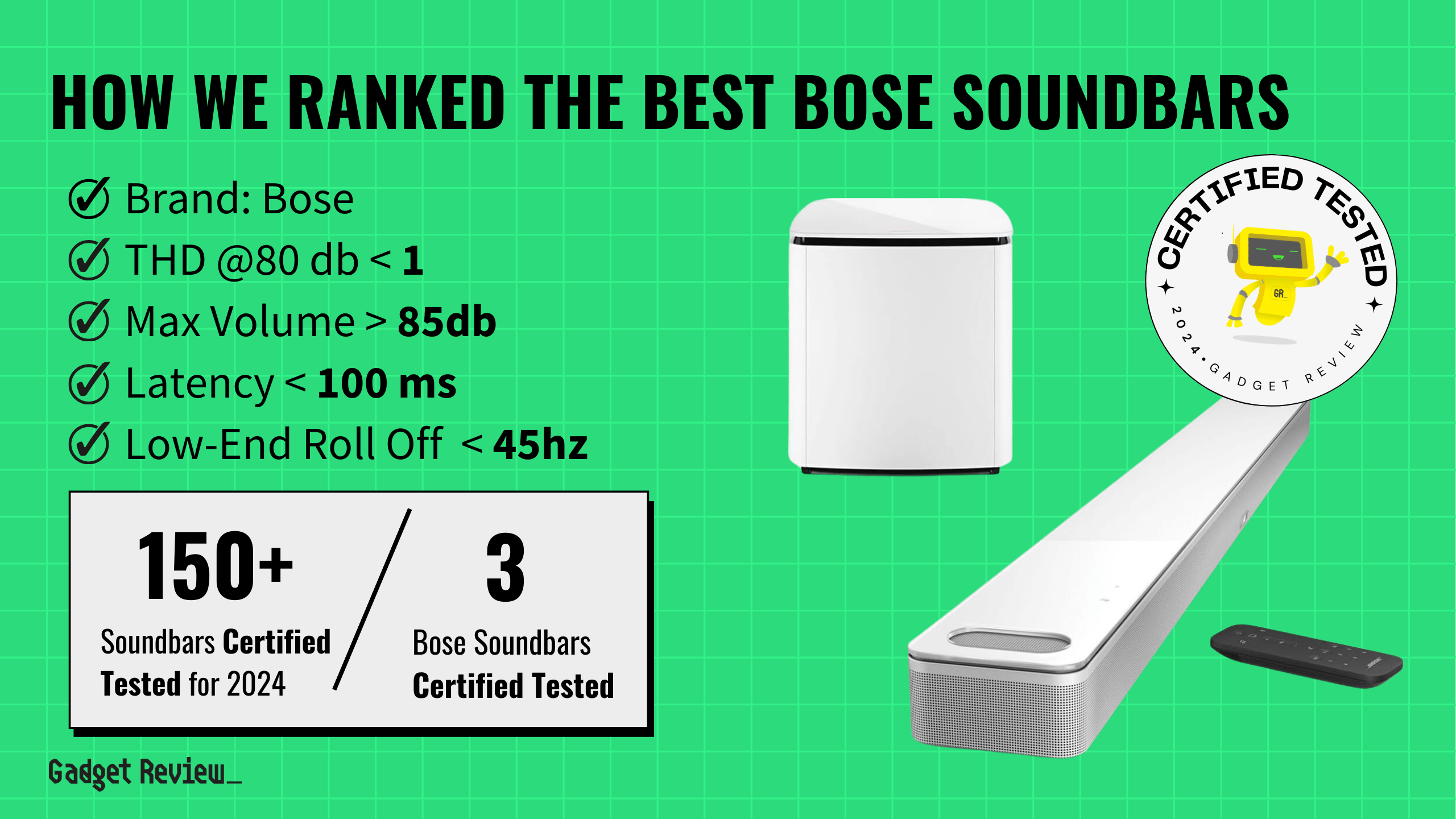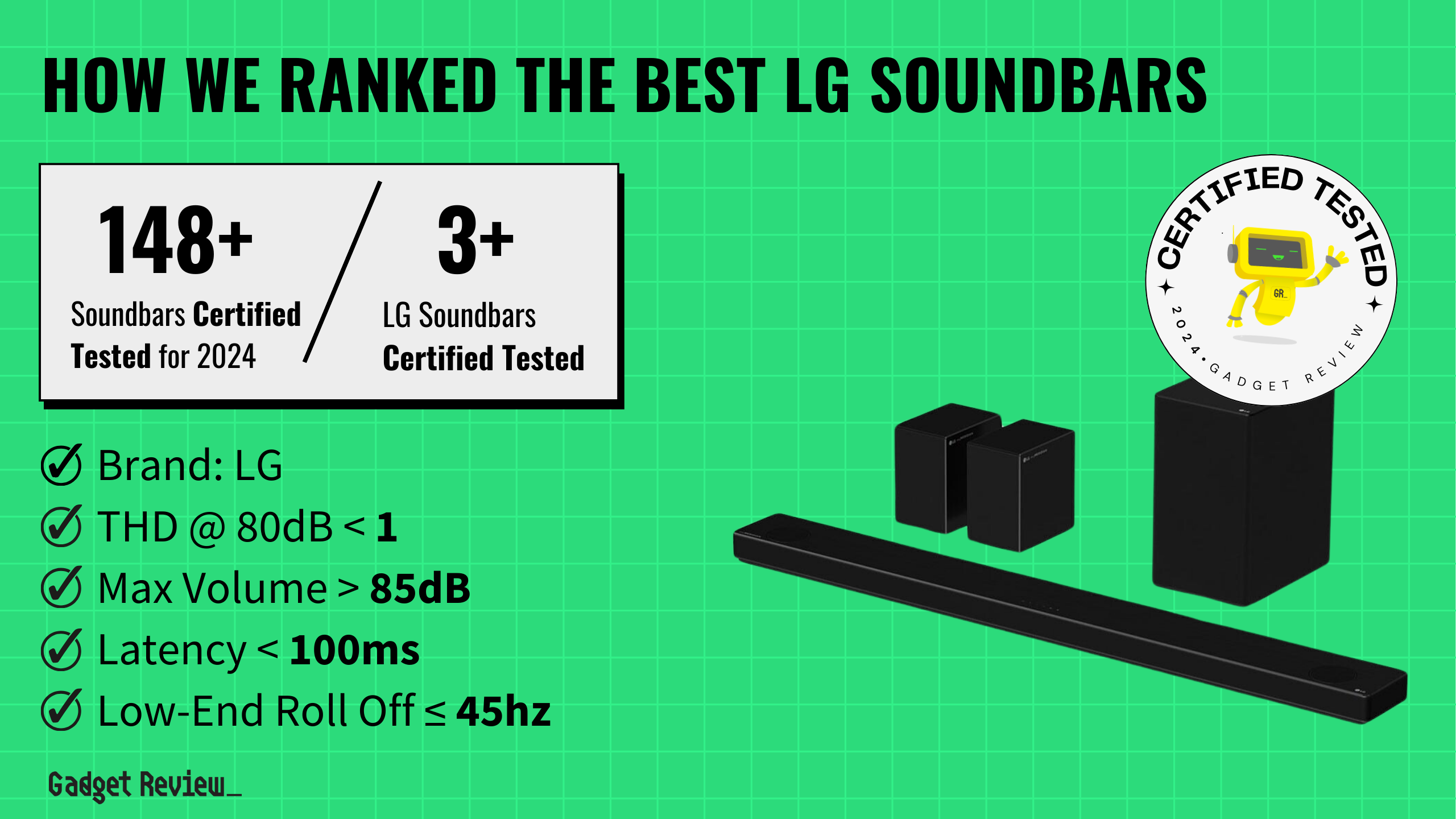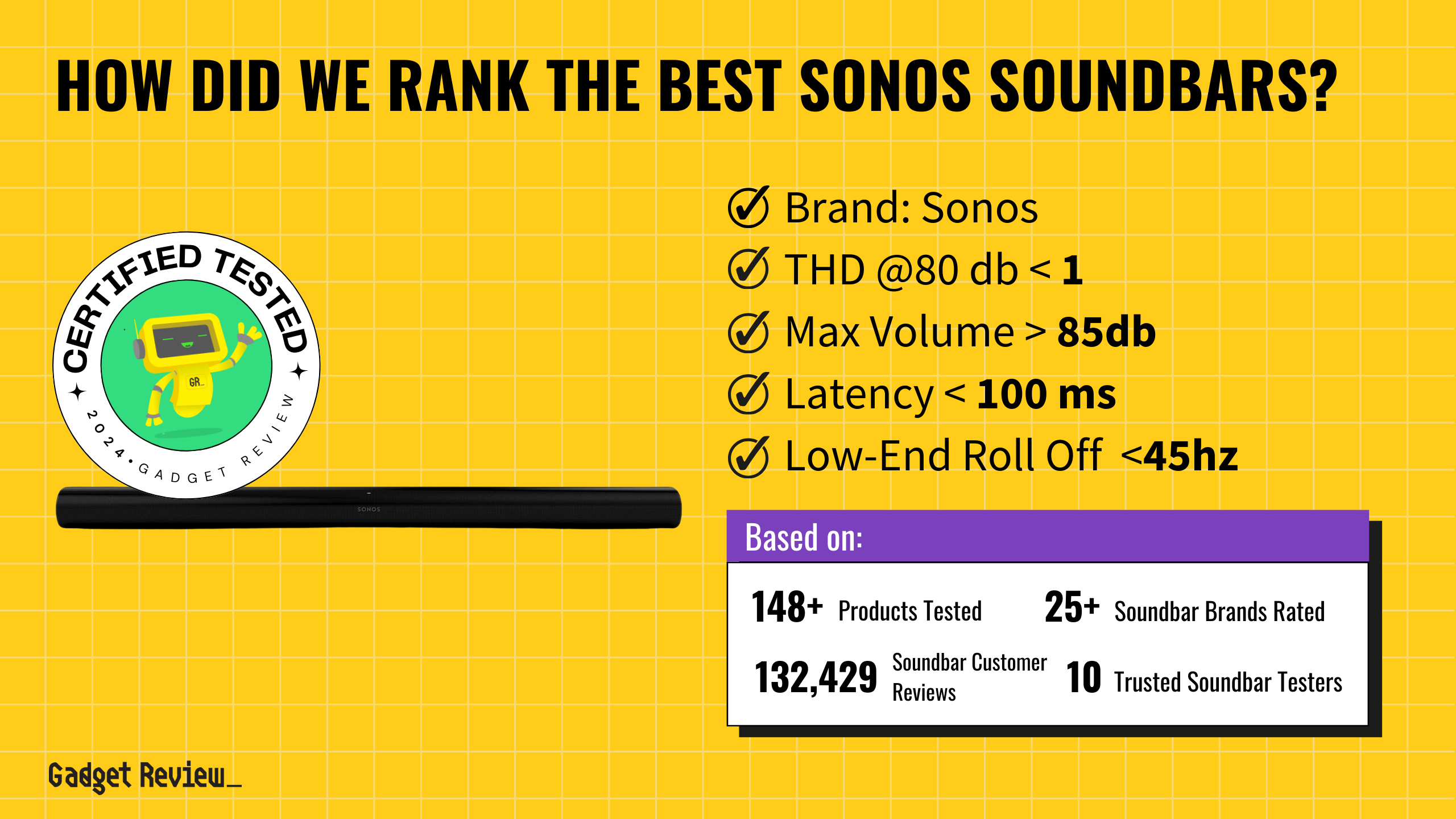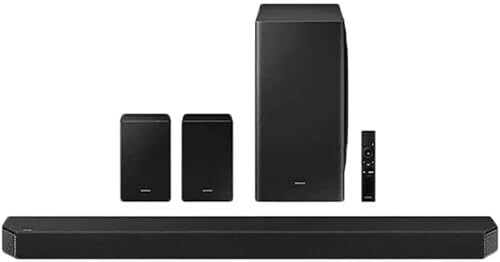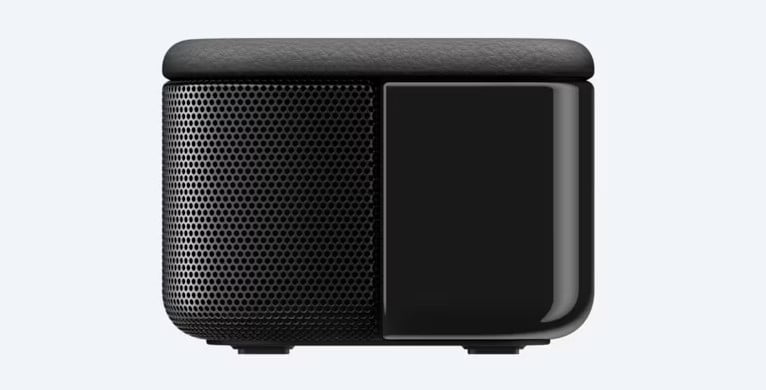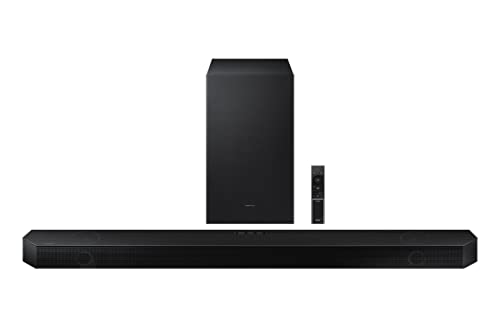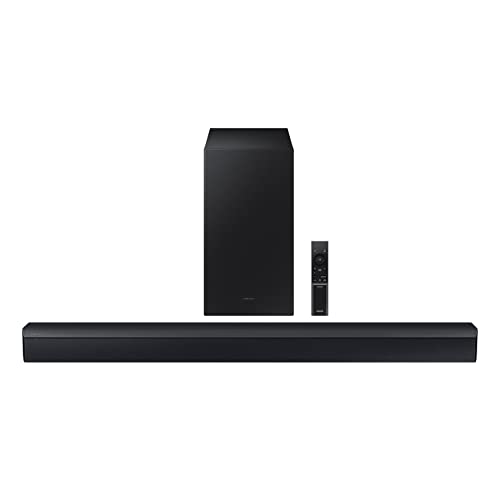A high-quality 5.1 soundbar immerses you in rich, detailed audio with powerful bass and clear dialogue. Look for strong connectivity and minimal latency to ensure seamless integration into your setup. Issues like poor connections and high latency can disrupt your experience, so finding a soundbar that excels in these areas is crucial.
By leveraging our True Score and Trust Rating, we filtered out fake reviews, ensuring you get outstanding soundbars that truly excel in real-world performance. We certified over 140 soundbars as tested, identifying three top performers. Our review process involved scrutinizing 412,267 customer reviews and found that 92% of experts weren’t trustworthy.
How Did We Rank the Best 5.1 Soundbars?
After analyzing customer reviews and expert opinions from more than 200 sites, we developed our guide for the best 5.1 soundbars. Our True Score system, combined with a detailed examination of testing methods, revealed 2 required test results, 2 nice-to-have features, and 2 essential specifications. This rigorous data-driven process ensures our recommendations are grounded in a solid understanding of what makes a soundbar truly exceptional. When you shop through our links, you’re backing our mission. Dive deeper to see how.
Minimum Specifications
- Must have 5.1 channel output
- Must have Dolby Atmos
Test Criteria
- Total Harmonic Distortion: A total harmonic distortion (THD) below 1% at 80 decibels to guarantee high-fidelity audio reproduction without unwanted frequencies.
- Volume Output: The soundbar should be able to deliver a powerful and immersive sound performance, exceeding 85 decibels in volume output.
“Nice To Haves”
- Latency: With a latency under 100 milliseconds, it ensures minimal delay in data transmission or audio processing.
- Low-End Roll Off: A low-end roll-off of <45 Hz to ensure there is plenty of thump and rumble in the bass to enhance your music or movie-watching experience.
Latest Updates
- 04/08/2024: Published the list of best 5.1 soundbars based on our True Score system.
Top 5.1 Soundbars For 2025
Prices accurate at the time of publishing
For a 5.1 soundbar to make our list, it must meet standards for audio excellence. If it falls short, it won’t make the cut!
Which Criteria Matters for Testing Best 5.1 Soundbars?
By focusing on these criteria (2 required, 2 nice to have), anyone can quickly and easily compare these soundbars and how they’ll perform. This helps you make an informed decision and purchase a soundbar that will sound great.
| CRITERIA | RANGE | REQUIRED | DEFINITION |
|---|---|---|---|
| Total Harmonic Distortion | < 1 | Yes | The amount of distortion introduced by the soundbar when it processes an audio signal at a given volume (typically 80, 85 or maximum dB output.) |
| Max Volume | > 85 dB | Yes | The maximum volume that a soundbar reaches when it’s output it turned up to 100%. |
| Latency | < 100 ms | No (nice to have) | The time it takes for a soundbar to process audio signal from a source and output it through the speakers. |
| Low End Roll Off | < 45 Hz | No (nice to have) | The point at which bass begins to sharply fall below the target response point on a frequency response graph, making harder to hear. |
Our Trusted Data Sources
(Publication category Score is 80%+)
We looked at 120+ soundbar reviewers and while 10 are trustworthy (60%+ Trust Rating), we only use data from the testers that are “very trusted” which means a Trust Rating above 70%. The three we have listed below are our most trusted for soundbars.
Interested in a comprehensive analysis of our data sources? We’ve got you covered. Below, you’ll find a detailed list of every soundbar review website we’ve identified, organized by their respective Trust Ratings from highest to lowest. But we didn’t stop there. We’ve meticulously reviewed each publication and verified the data by checking whether the authors have bio links to MuckRack or LinkedIn. We’re committed to not only checking the facts but ensuring their veracity.
Soundbars Test Data & Results
1. Low end roll off test result
Low end roll off
< 45 Hz
Acceptable range of performance
Definition: The point at which bass begins to sharply decline and becomes rapidly inaudible.
Units of Measurement: Hz (Hertz)
Tools to Measure: Oscilloscope
Why It’s Important:
If bass takes longer to start rolling off, it’ll generally be more present in the audible parts of the audio spectrum put out by a soundbar, giving sound “punch” and “depth.”
When it comes to getting the most bass you can out of your soundbar, low-end roll off is a great indicator of just how deep the bass on it can get. If a soundbar doesn’t have a roll off that starts deep enough into the bass part of the audio spectrum, then it’ll result in quiet or even absent bass, which removes most of the punch and impact of not only music, but also movies and video games. the longer it takes bass to roll off, the better.
When it comes to most soundbars for most use cases, we recommend a roll off that doesn’t start until at least 45 Hz, but it only gets better the further you go down. It’s worth noting that the roll off will only get so low, so don’t expect to find soundbars hitting the teens for roll off, but it isn’t uncommon for very bass-forward options to hit 30 Hz before roll off starts. By aiming for at least 45 Hz, you have a much better chance of getting the deep, rumbling bass you’re looking for out of your music, movies or games.
Low end roll off (in Hz; lower is better)
2. max volume test result
Maximum volume is the easiest aspect of a soundbar to understad: it’s just how loud the soundbar itself will actually get. What’s less clear is why a soundbar getting loud is so important. While higher max volumes give you the ability the fill rooms with sound or use a soundbar as makeshift party speakers, they’re also responsible for helping ensure that audio stays clear when listening at normal listening levels.
This is commonly referred to as “headroom”, and having enough headroom on a soundbar means that the soundbar is able to play back sounds at a high enough level (and with good enough clarity) that the volume level you’ll normally listen to music, movies or games with will sound perfectly clear and distortion free. We recommend your soundbar have no less than 85 dB of maximum volume, but getting past 91 dB is ideal, and the higher you go, the better your soundbar is at filling larger and larger rooms.
max volume
> 85 dB
Acceptable range of performance
Definition: The maximum volume that a soundbar is able to hit when the output is turned all the way up.
Units of Measurement: dB (Decibels)
Tools to Measure: Sound level or decibel meter
Why It’s Important:
Max volume is how you ensure you’ve got enough volume to fill large rooms and helps ensure clarity at normal listening levels.
Max Volume (in dB; higher is better)
3. latency test result
latency
< 100 ms
Acceptable range of performance
Definition: Time it takes for the soundbar to process and produce the sound it receives from the source
Units of Measurement: milliseconds (ms)
Tools to Measure: Software
Why It’s Important:
Long delays create mismatches between audio and video, which breaks immersion and frustrates gamers.
Large amounts of latency create problems when trying to sync up audio and video. While you’ve got a bit of wiggle room with how much of a delay can exist between the audio that comes out of your soundbar and the images on your TV, it’s not a ton. If there’s too much latency the mismatch starts to become obvious, and people start looking like they stopped talking while dialogue is still playing. This is especially concerning for gamers, who rely on audio and video to sync up well enough that the footprints you hear around the corner are accurately getting closer.
It’s for these reasons we recommend a latency less than 100 ms. For most content, this is a low enough delay that any mismatch is going to be largely unnoticed. If you’re a highly competitive gamer and don’t want to do calibration out of the box to line up the A/V, the lowest latency you can find is going to work best. For music and moves, though, 100 ms or less will work great.
Latency (in milliseconds; lower is better)
4. total harmonic distortion test result
Total Harmonic Distortion (THD) measures the fidelity of soundbars by indicating the percentage of unwanted harmonics added to the original audio. A THD under 1 ensures minimal distortion, critical for preserving audio quality across music, movies and games. This low distortion level enhances clarity, maintains detail, and ensures a high-fidelity listening experience, crucial for understanding dialogues, appreciating music nuances, and immersing in game sounds.
We believe soundbars should have less than 1% THD because this helps confirm their ability to accurately reproduce a wide range of audio without perceptible distortion. We say “perceptible” because it’s impossible to remove all distortion, but you can reduce it to the point it’s impossible to notice. Low THD also helps improve your comfort by preventing fatigue during extended use, making it an essential for anyone that marathons movies, games or music.
harmonic distortion
< 1
Acceptable range of performance
Definition: The amount of distortion that exists in an audio signal when it is played back at a target volume.
Units of Measurement: None or %
Tools to Measure: Audio Analyzer
Why It’s Important:
High levels of distortion ruin audio quality. Keeping distortion low helps keep music accurate and high-fidelity.
Total Harmonic Distortion (lower is better)
Best 5.1 Soundbars: Mistakes To Avoid
- Disregarding Room Size: Avoid selecting a 5.1 soundbar without considering your room’s dimensions, as mismatched sizing can impact audio distribution and overall performance. For smaller spaces, the best small soundbar can provide a balanced and immersive audio experience without overwhelming the room, ensuring that you don’t compromise on sound quality or spatial harmony.
- Neglecting Connectivity: Don’t overlook connectivity options, as lacking features like Bluetooth or HDMI ARC can limit compatibility with your devices and reduce flexibility in usage. For gamers, the best gaming soundbar with low-latency Bluetooth and HDMI ARC ensures seamless audio sync and versatile connections to consoles and PCs, enhancing the gaming experience with crisp, timely sound.
- Ignoring Subwoofer Placement: Ensure you don’t place the subwoofer in an inconvenient location or overlook its placement altogether, as proper positioning is crucial for balanced bass distribution and optimal sound quality. Soundbar placement is equally important; it should complement the subwoofer’s position to create a cohesive audio environment. Choosing the best soundbar with a subwoofer involves considering how both components will integrate into your space to deliver superior sound.
- Sacrificing Audio Quality for Features: Avoid prioritizing fancy features over audio quality, as some models may offer a multitude of functionalities but compromise on sound performance, resulting in a less satisfying listening experience. For audiophiles and music enthusiasts, the best soundbar for music should deliver rich, detailed sound with balanced bass, clear mids, and crisp highs, ensuring every note and lyric is heard in full clarity.
The Best 5.1 Soundbars Tests Compared
Product |
True Score
|
Low End Roll Off
|
High End Roll Off
|
Max Volume Test
|
Latency
|
THD @ 80dB
| |
|---|---|---|---|---|---|---|---|
| 84 |
|
|
|
|
| $647.95 $998 $350 |
Bose Smart Soundbar 900 With Speakers + Bass Module
| 81 |
|
|
|
|
| $749.99 |
| 79 |
|
|
|
|
| $429.95 |


